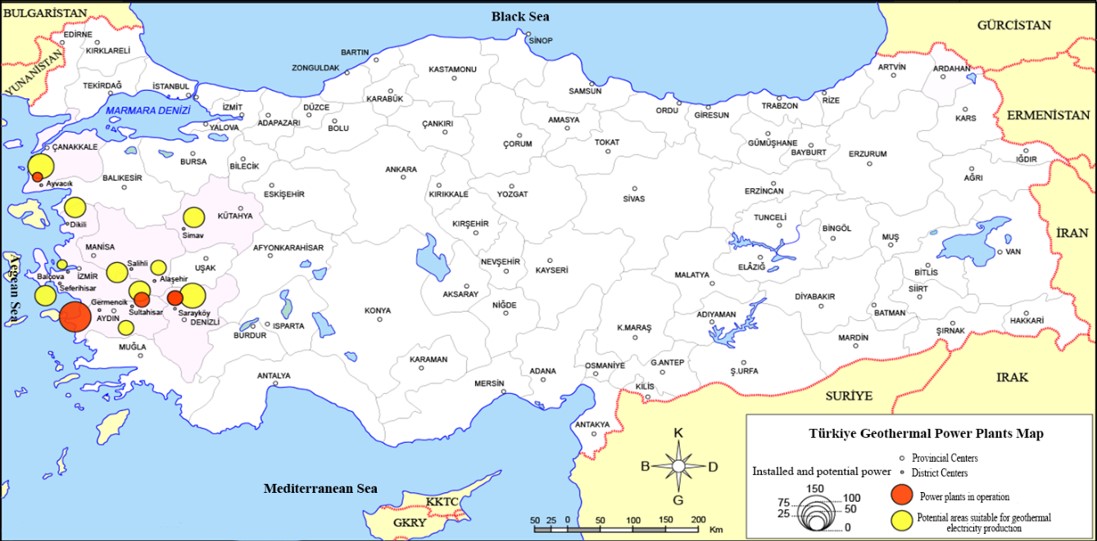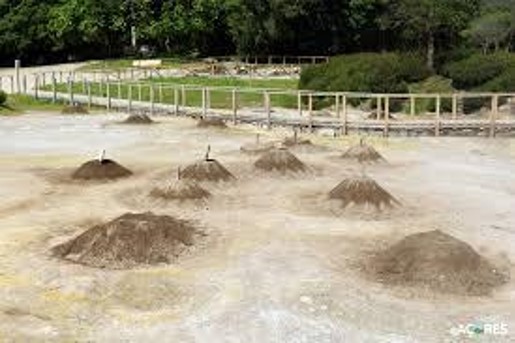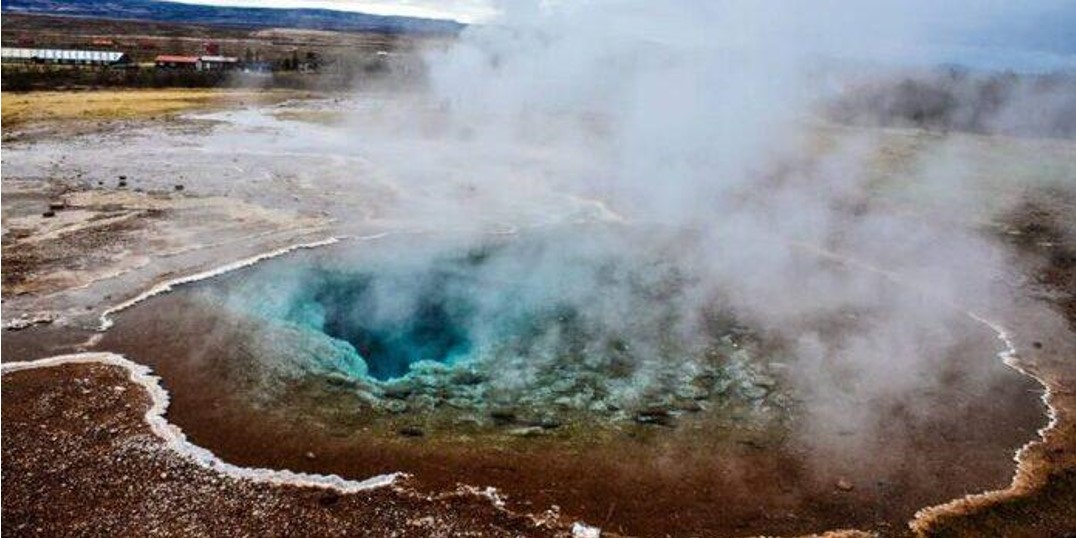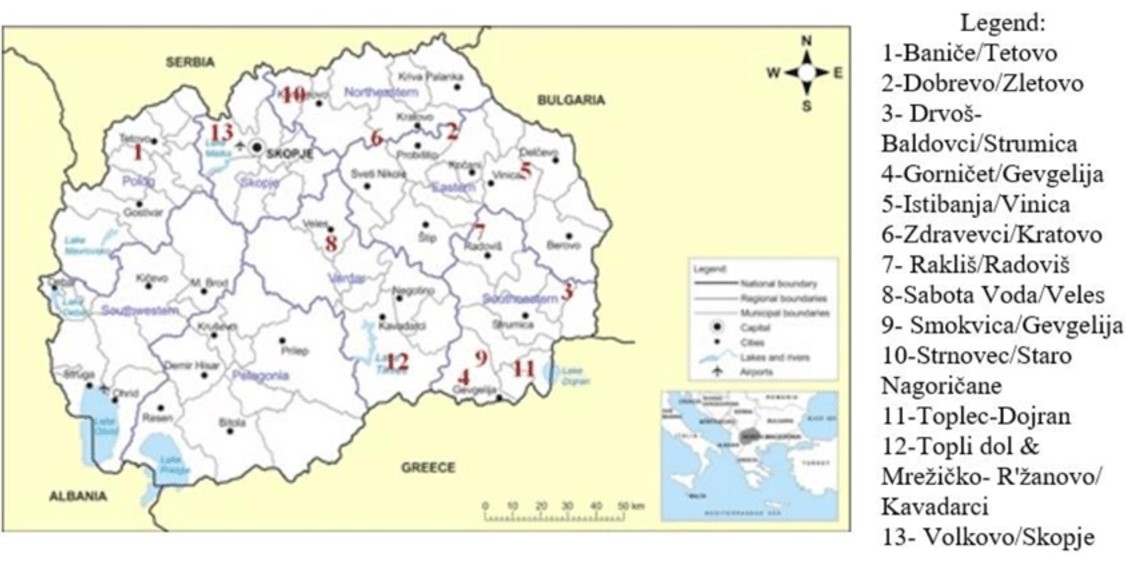- Definition and Types of Energy
- Myths And Misconceptions About Energy
- The Relationship Between Energy and Environment
- Climate Change and Carbon Footprint
- Greenhouse Gas Effect
- The Role of Human-Induced Greenhouse Gases and Energy Consumption
- Energy Efficiency and Sustainability
- Renewable Energy Sources and Future Perspectives
- Play and Learn
- Solar Energy Conversions
- Solar Energy Worldwide
- Solar Energy in Partner Countries
- Positive and Negative Impacts
- Technologies for Harnessing Solar Energy
- Solar thermal energy technologies and applications
- Electricity Generation Methods
- Passive Heating and Cooling of Residences with the Sun
- Concentrator solar power (CSP) systems and electricity generation
- Systems and Applications That Generate Electricity directly from solar rays
- Photovoltaic Cells and Panels
- Domestic PV Systems
- Off-Grid PV Systems
- Hybrid Connected Systems
- Materials Used in PV Cells
- Play and Learn
Geothermal Energy in Partner Countries
Geothermal Energy in Türkiye
Türkiye is a country rich in geothermal resources as it is located in the Alpine-Himalayan belt. The total geothermal potential of our country is estimated to be approximately 62,000 MW. Of this potential, 31,500 MW is suitable for direct use and 1,734 MW for electricity generation. Türkiye ranks first in Europe and fourth in the world with this capacity.
The first heat energy use using geothermal resources in Türkiye began in 1964 with the heating of the Park Hotel in Balıkesir-Gönen. Today, nearly 15 thousand houses in İzmir are heated with geothermal energy. After 2000, studies on geothermal energy in Türkiye have accelerated, and direct usage areas such as thermal tourism, greenhouse farming and central heating of houses have become widespread.
There are nearly 1,000 geothermal resources in our country, and 11 regions stand out as efficient in terms of electricity generation:
- Aydın-Germencik (232 °C)
- Manisa-Salihli Göbekli (182 °C)
- Çanakkale-Tuzla (174 °C)
- Aydın-Salavatlı (171 °C)
- Kütahya-Simav (162 °C)
- İzmir-Seferihisar (153 °C)
- Manisa-Salihli Caferbey (150 °C)
- Aydın-Yılmazköy (142 °C)
- İzmir-Balçova (136 °C)
- İzmir-Dikili (130 °C)

Türkiye has significant potential in geothermal energy and is ranked 4th in the world with an installed capacity of 1,734 MW as of 2024. There are approximately 1,000 geothermal resources in the country in the form of natural outlets and at different temperatures, and the total discovered geothermal potential is calculated as 62,000 MW. Türkiye aims to increase the share of geothermal in its total installed electrical energy capacity to 8% by 2053 and to meet all residential heating use from geothermal energy.
Geothermal Energy in Portugal
In mainland Portugal, geothermal energy is widespread all over the territory but only related to systems of low enthalpy (greater than 150ºC). It is mainly used for balneotherapy, space and greenhouse heating, drying wood, fruits and vegetables, and aquaculture, among other uses.
The Azores archipelago, a group of nine outermost islands 1500 km from the Portuguese mainland coast, is the part of the country where geothermal energy is more developed. Due to its volcanic origin and its location at a tectonic plate boundary (which corresponds to a triple junction of the Eurasian, American, and African plates), the Azores have great geothermal potential.

One of the main attractions of São Miguel Island is the "Cozido das Furnas" (figure), a typical dish of the local cuisine, which is cooked in holes dug in a field by taking advantage of geothermal energy. In addition to this, there are numerous other activities linked to the use of geothermal energy, both for leisure and commercial purposes. There are also electricity power plants on the islands of São Miguel and Terceira, contributing about 25% to the electricity consumed in the archipelago.
The first experimental geothermal production plant in the Azores was built in 1980 in Pico Vermelho, on the island of São Miguel.
The largest geothermal power plants in operation are those of Pico Vermelho (13 MW) and Ribeira Grande (16.6 MW), both on the island of São Miguel, and the geothermal power plant of Pico Alto (4.7 MW), on Terceira island.
The project to expand the Pico Vermelho Geothermal Power Plant is currently underway, exploring new geothermal sources that will have the capacity to double the 12 MW of power currently installed.
The Portuguese government recently presented the "Strategic Plan for Geothermal" energy, which aims to multiply by 10 the number of surface geothermal systems installed in the Portuguese mainland, compared to those existing in 2023, as well as to multiply by 5, compared to 2023, the geothermal energy used as a result of the exploitation of geothermal resources.
Geothermal Energy in Greece
Greece is endowed with substantial geothermal resources due to its location in the Mediterranean-Volcanic Belt, which places it within a region rich in geothermal potential. The country's geothermal capacity is particularly significant in areas with active volcanic activity and tectonic movement, such as the Aegean Islands and parts of the mainland. Greece’s total geothermal potential is estimated at around 5,000 MW, with both direct-use and electricity generation applications. Despite this considerable potential, Greece has not fully exploited its geothermal resources to the extent of other countries with similar resources.
The first use of geothermal energy for heating in Greece began in the 1980s, with the establishment of district heating systems in regions such as the island of Lesvos and the town of Agios Nikolaos on Crete. Since then, the use of geothermal energy has expanded, with applications in residential heating, agricultural processes like greenhouse farming, and thermal tourism. The geothermal resources in Greece are primarily utilized for district heating and for the heating of private homes, with the island of Lesvos being a prominent example of successful geothermal utilization.
As of 2023, Greece has made significant progress in utilizing geothermal energy, with a total installed capacity of approximately 160 MW, most of which is used for direct applications. The country has about 50 known geothermal fields, with the most significant resources located on islands like Milos, Nisyros and Santorini, as well as in parts of the mainland such as the northern and central regions. Some of the major geothermal fields include the Milos Island field, with a temperature of up to 300 °C, and the Nisyros field, which has proven to be a significant source for both electricity generation and direct use.
While Greece has been a leader in geothermal direct use in Europe, its electricity generation from geothermal remains limited. The potential for geothermal electricity generation is being explored, particularly in high-temperature fields, with plans for future expansion. The Greek government has identified geothermal energy as a key component of its renewable energy strategy and aims to increase its contribution to the national energy mix. The country is also focusing on the development of new geothermal plants and expanding the infrastructure for geothermal heating. By 2030, Greece aims to significantly increase the share of geothermal energy in its overall energy capacity, contributing to both the decarbonization of its energy sector and the enhancement of energy security.
In conclusion, while Greece has significant geothermal potential, there is still room for growth, especially in the generation of electricity from geothermal resources. The country is working to tap into its geothermal capacity more effectively and diversify its renewable energy sources, thus making geothermal energy an integral part of its sustainable energy future.
Greece is endowed with substantial geothermal resources due to its location in the Mediterranean-Volcanic Belt, which places it within a region rich in geothermal potential. The country's geothermal capacity is particularly significant in areas with active volcanic activity and tectonic movement, such as the Aegean Islands and parts of the mainland. Greece’s total geothermal potential is estimated at around 5,000 MW, with both direct-use and electricity generation applications. Despite this considerable potential, Greece has not fully exploited its geothermal resources to the extent of other countries with similar resources.
The first use of geothermal energy for heating in Greece began in the 1980s, with the establishment of district heating systems in regions such as the island of Lesvos and the town of Agios Nikolaos on Crete. Since then, the use of geothermal energy has expanded, with applications in residential heating, agricultural processes like greenhouse farming, and thermal tourism. The geothermal resources in Greece are primarily utilized for district heating and for the heating of private homes, with the island of Lesvos being a prominent example of successful geothermal utilization.
As of 2023, Greece has made significant progress in utilizing geothermal energy, with a total installed capacity of approximately 160 MW, most of which is used for direct applications. The country has about 50 known geothermal fields, with the most significant resources located on islands like Milos, Nisyros, and Santorini, as well as in parts of the mainland such as the northern and central regions. Some of the major geothermal fields include the Milos Island field, with a temperature of up to 300 °C, and the Nisyros field, which has proven to be a significant source for both electricity generation and direct use.
While Greece has been a leader in geothermal direct use in Europe, its electricity generation from geothermal remains limited. The potential for geothermal electricity generation is being explored, particularly in high-temperature fields, with plans for future expansion. The Greek government has identified geothermal energy as a key component of its renewable energy strategy and aims to increase its contribution to the national energy mix. The country is also focusing on the development of new geothermal plants and expanding the infrastructure for geothermal heating. By 2030, Greece aims to significantly increase the share of geothermal energy in its overall energy capacity, contributing to both the decarbonization of its energy sector and the enhancement of energy security.
In conclusion, while Greece has significant geothermal potential, there is still room for growth, especially in the generation of electricity from geothermal resources. The country is working to tap into its geothermal capacity more effectively and diversify its renewable energy sources, thus making geothermal energy an integral part of its sustainable energy future.

Geothermal Energy in North Macedonia
North Macedonia, situated along the favorable geothermal zone extending from Hungary through Italy to Greece, possesses notable geothermal potential. The country's geothermal resources are primarily characterized by low-temperature systems, with medium and high-temperature potentials remaining largely unexplored.
Historically, North Macedonia has utilized geothermal energy for various applications, including district heating, greenhouse farming, and spa tourism. The Kočani Valley, for instance, is renowned for its thermal springs, with water temperatures ranging between 70-80°C, supporting local agriculture and heating needs. However, over the past three decades, the development and utilization of geothermal energy have stagnated, primarily due to a lack of investments and disputes over ownership rights of geothermal resources.
In terms of technical potential, geothermal energy could contribute an estimated 10 MW to North Macedonia's energy mix. This potential remains largely untapped, with current utilization focused on direct applications rather than electricity generation. The country's geothermal resources are primarily characterized by low-temperature systems, with medium and high-temperature potentials remaining largely unexplored.

The underutilization of geothermal energy presents an opportunity for North Macedonia to diversify its energy sources and enhance energy security. By investing in the exploration and development of geothermal resources, the country could reduce reliance on fossil fuels and promote sustainable energy practices. Additionally, revitalizing the spa tourism sector, which has experienced a decline due to underinvestment, could stimulate economic growth and attract international visitors.
In conclusion, while North Macedonia possesses significant geothermal potential, realizing this capacity requires strategic investments, policy support, and technological advancements. By addressing these challenges, the country can harness geothermal energy to meet heating demands, support agricultural practices, and potentially generate electricity, contributing to a more sustainable and diversified energy future.